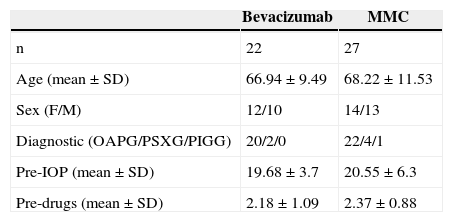The objective of this study is to compare the efficacy and safety of bevacizumab versus mitomycin C as an adjuvant anti-scarring agent in trabeculectomy.
MethodsA prospective, comparative, non-randomized, interventional study was conducted on a case series. A total of 49 eyes of 45 patients with uncontrolled glaucoma were recruited: 22 eyes in the bevacizumab (BVZ) group, and 27 eyes in the mitomycin C (MMC) group. Complete success was defined as intraocular pressure (IOP) less than 18mmHg without any antiglaucoma medications. Follow-up visits were made on 1, 7, 30, 90 and 180 days after the surgery. Visual acuity, mean IOP, number of antiglaucoma medications and additional procedures to control IOP were recorded at each follow up visit. Local and systemic complications were also noted.
ResultsAt the end of the follow-up there were no significant differences in mean IOP between groups: mean IOP was 13.4±3.5mmHg (range 8–20) in the BVZ group and 11.6±2.6mmHg (range 7–17) in the MMC group (p=.08). Complete success was achieved in 77.2% (17 out of 22) in the BVZ group and 96.2% (26 out of 27) in the MMC group, which was a statistically significant difference (p=.024). More patients required antiglaucoma medications to control IOP in the BVZ group at the end of the study: 0.36±0.72 medications versus 0.03±0.19 medications in the MMC group (p=.018). Three patients developed avascular cystic blebs in the BVZ group. None of the patients suffered any ocular or systemic complications related to the use of these agents.
ConclusionBevacizumab could be a safe and effective anti-scarring agent; however IOP reduction appears to be greater with MMC, and also less antiglaucoma medications are needed with this anti-scarring agent. Bevacizumab could favor the formation of avascular cystic blebs.
Comparar la eficacia y seguridad de bevacizumab como adyuvante a la trabeculectomía frente a mitomicina C.
MétodoSe diseñó un estudio comparativo prospectivo no aleatorizado de 180 días de duración con 49 ojos de 45 pacientes: 22 ojos en el grupo de bevacizumab (BVZ) y 27 ojos en el grupo de mitomicina C (MMC). Se estableció como éxito completo: presión intraocular (PIO) menor de 18mmHg sin fármacos adyuvantes. Se realizaron controles en los días 1, 7, 30, 90 y 180 poscirugía. Se evaluaron: agudeza visual, PIO media en cada una de las visitas, procedimientos adicionales y número de fármacos necesarios para el control de la PIO poscirugía, así como posibles complicaciones posquirúrgicas tanto locales como sistémicas.
ResultadosAl final del estudio en la PIO media postoperatoria fue 13,4±3,5mmHg (rango 8–20) en el grupo del BVZ y de 11,6±2,6mmHg (rango 7–17) en el grupo de la MMC sin encontrar diferencias estadísticamente significativas (p=0,08). Se alcanzó el éxito completo al final del seguimiento en un 77,2% (17 de 22) de los pacientes en el grupo de BVZ y en un 96,2% (26 de 27) en el grupo de MMC, siendo esta diferencia estadísticamente significativa (p=0,024). Un mayor número de pacientes requirió fármacos adicionales para el control de la presión en el grupo de BVZ al final del seguimiento: 0,36±0,72 fármacos frente a 0,03±0,19 fármacos en el de la MMC (p=0,018). Se encontraron 3 casos de ampollas avasculares en el grupo del BVZ y ninguno en el grupo de MMC. Ningún paciente desarrolló complicaciones derivadas del uso de los medicamentos.
ConclusionesBevacizumab parece ser un fármaco eficaz y seguro como adyuvante a trabeculectomía, sin embargo la reducción de la presión es algo mayor con la MMC con una menor necesidad de medicación hipotensora. Existe la posibilidad de formación de ampollas avasculares con el uso de bevacizumab intraoperatorio.










